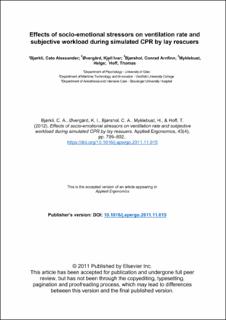| dc.contributor.author | Bjørkli, Cato Alexsander | |
| dc.contributor.author | Øvergård, Kjell Ivar | |
| dc.contributor.author | Bjørshol, Conrad Arnfinn | |
| dc.contributor.author | Myklebust, Helge | |
| dc.contributor.author | Hoff, Thomas | |
| dc.date.accessioned | 2021-06-17T08:48:42Z | |
| dc.date.available | 2021-06-17T08:48:42Z | |
| dc.date.created | 2012-01-16T17:58:53Z | |
| dc.date.issued | 2012 | |
| dc.identifier.citation | Bjørkli, C. A., Øvergård, K. I., Bjørshol, C. A., Myklebust, H., & Hoff, T. (2012). Effects of socio-emotional stressors on ventilation rate and subjective workload during simulated CPR by lay rescuers. Applied Ergonomics, 43(4). | en_US |
| dc.identifier.issn | 0003-6870 | |
| dc.identifier.uri | https://hdl.handle.net/11250/2759902 | |
| dc.description.abstract | Several studies have documented the occurrence of high ventilation rates during cardiopulmonary resuscitation, but to date, there have been no scientific investigation of the causes of hyperventilation. The objective of the current study was to test the effects of socio-emotional stressors on lay rescuers’ ventilation rate in a simulated resuscitation setting using a manikin model. A within-subjects experiment with randomized order of conditions tested lay rescuers’ ventilation rate on an intubated manikin during exposure to socio-emotional stressors and during a control condition where no external stressors were present. Ventilation rates and subjective workload were significantly higher during exposure to socio-emotional stressors than during the control condition. All but one of the nine participants ventilated at a higher ventilation rate in the experimental condition. All nine participants rated the subjective workload to be higher during exposure to socio-emotional stressors. Hence, exposure to socio-emotional stressors is associated with increased ventilation rates performed by lay rescuers during simulated cardiac arrest using a manikin model. These findings might have implications for the understanding of the type of situations which hyperventilation may occur. Awareness of these situations may have implications for training of lay rescues. | en_US |
| dc.language.iso | eng | en_US |
| dc.rights | Attribution-NonCommercial-NoDerivatives 4.0 Internasjonal | * |
| dc.rights.uri | http://creativecommons.org/licenses/by-nc-nd/4.0/deed.no | * |
| dc.title | Effects of socio-emotional stressors on ventilation rate and subjective workload during simulated CPR by lay rescuers | en_US |
| dc.type | Peer reviewed | en_US |
| dc.type | Journal article | en_US |
| dc.description.version | acceptedVersion | en_US |
| dc.rights.holder | Copyright © 2011 Elsevier Ltd and The Ergonomics Society. | en_US |
| dc.source.volume | 43 | en_US |
| dc.source.journal | Applied Ergonomics | en_US |
| dc.source.issue | 4 | en_US |
| dc.identifier.doi | https://doi.org/10.1016/j.apergo.2011.11.015 | |
| dc.identifier.cristin | 887288 | |
| cristin.ispublished | true | |
| cristin.fulltext | original | |
| cristin.qualitycode | 1 | |

